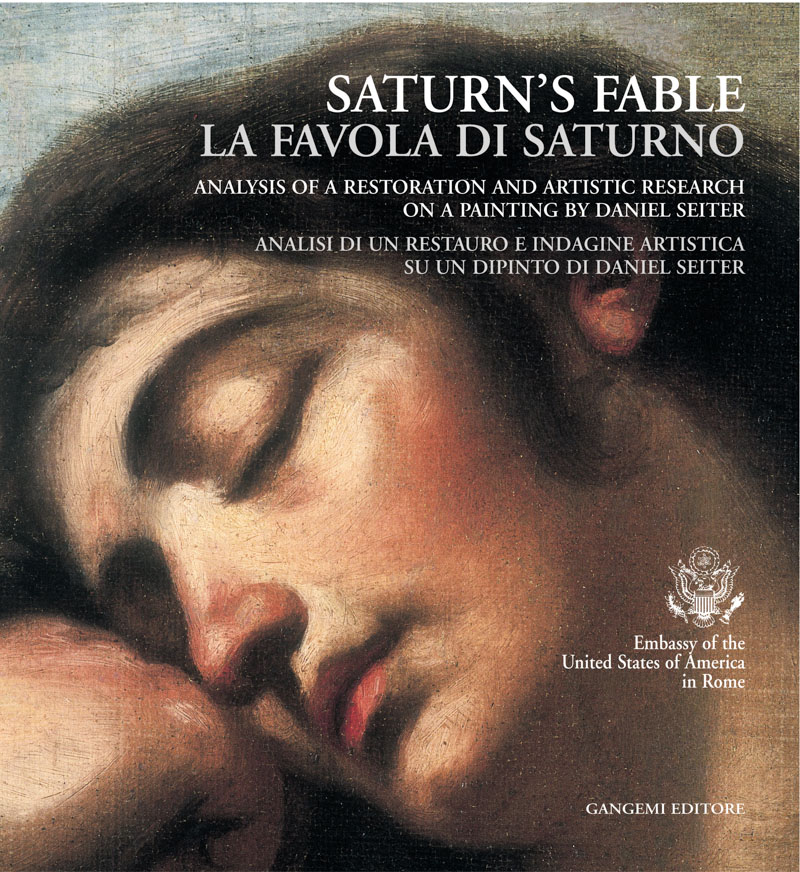
Fuori commercio
Saturn’s Fable. La Favola di Saturno
Analysis of a restoration and artistic research on a painting by Daniel Seiter / Analisi di un restauro e indagine artistica su un dipinto di Daniel Seiter
A cura di: Brunori Valeria
Autori: Embassy of the U.S. of America in Rome
Facing English text
Formato: 22 x 24 cm
Legatura: Filorefe
Pagine: 96
Anno edizione: 2005
ISBN: 9788849208481
EAN: 8849208480
UB. INT. : T451f V14f V16g
Contenuto
All’Ambasciata degli Stati Uniti d’America a Roma va lode meritevole per aver promosso il restauro di un importante dipinto di Daniel Seiter ed essersi assunta l’onere di questa pubblicazione; in essa confluiscono i risultati congiunti di un brillante lavoro tecnico, svolto con la consulenza scientifica della Soprintendenza per il Polo Museale Romano.
Il magnifico intervento di restauro, affidato alla cura attenta e intelligente di Valeria Brunori, ha dato in corso d’opera esiti insospettabili; la straordinaria perizia con la quale la Brunori ha agito sul tessuto pittorico, prima interpretato poi trattato con finezza esecutiva, ha consentito di pervenire ad una lettura inedita della storia del dipinto sollecitando una ricerca chiarificatrice sul significato dell’opera.
Pertanto, lo studio di Antonella Pampalone, qui pubblicato, fa luce su un aspetto fondamentale della storia dell’arte della pittura verso la fine del Seicento a Roma. Nell’indagare, con nuovi argomenti e nuove deduzioni, sulla committenza di Pietro Gabrielli, la studiosa riesce a ricomporre un quadro coerente e unitario di un ambiente culturale estremamente complesso e contraddittorio di cui soltanto da poco tempo gli storici stanno prendendo piena cognizione. Ma è logico che le cose stiano così perché nella Roma della seconda metà del diciassettesimo secolo occorre distinguere bene livelli diversi di attività politica, sociale e artistica e bisogna capire sul serio come alcuni aspetti vadano giudicati per quello che appaiono e altri per quello che nascondono. La città dei Papi conobbe infatti, in quel tempo, esperienze molto variegate. Sembra predominare, in tanti comportamenti, una sconcertante superficialità che genera, sul piano artistico, una produzione ripetitiva e asfissiante di quadri di decorazione, Paesaggi e Nature Morte soprattutto, destinati, sostanzialmente, a non essere neppure guardati ma solamente scorti a fare pompa di sé nei solenni e fastosi arredi delle dimore nobiliari. È questo un punto su cui ancora oggi si tende poco a indagare, mentre risulta degno di particolare considerazione.
Ma, a fronte di questo vastissimo universo pittorico, urgeva tutto un mondo che annoverava artisti assolutamente attenti a una committenza per la quale l’opera d’arte doveva essere veicolo privilegiato di discussione e approfondimento di contenuti concreti. Predominava, qui, la ricerca del significato e in questa dialettica si consumò gran parte del dibattito artistico della Roma di fine Seicento.
Lo studio della Pampalone riguarda, in tale ottica, un quadro importante che segnò, in sostanza, il cambio del “testimone” tra due grandi protagonisti di quegli anni: Giacinto Brandi e Daniel Seiter. Il dipinto, infatti, oggi conservato presso l’Ambasciata degli Stati Uniti d’America a Roma, segna proprio il momento finale della parabola intensissima del Brandi e l’inizio di quella del Seiter in rapporto alla committenza di Pietro Gabrielli, uomo straordinario, intellettuale trasgressivo in bilico tra un passato ancestrale di sapienza alchemica e misteriosofica e un futuro utopico di slancio scientifico e di rinnovamento etico oltre ogni barriera e condizionamento delle gerarchie.
È notevole osservare come l’iconografia del quadro non sia decifrabile soltanto attraverso le fonti letterarie, ma costituisca, di fatto, una complessa elaborazione in cui si intrecciano i fervidi temi promananti dai più avanzati ambienti culturali del tempo, primo fra tutti quello gravitante attorno a Cristina di Svezia; proprio questo assegna all’opera un fascino straordinario.
Il recupero della solenne pittura “filosofica” della Favola di Saturno che Seiter compie sulla traccia delle idee figurative del Brandi rende, dunque, questo studio della Pampalone un modello di ricerca su quel momento cruciale della storia dell’arte a Roma, ampliando le prospettive di indagine su un epoca intera che continua a riservare cospicue sorprese e scoperte per chi, come appunto l’insigne studiosa, scruta gli eventi storici con una consapevolezza capace di sgombrare il campo da pregiudizi e luoghi comuni per un reale avanzamento delle conoscenze.
Claudio Strinati
Soprintendente per il Polo Museale Romano
The Embassy of the United States of America in Rome deserves the highest praise for promoting the restoration of an important painting by Daniel Seiter and for sponsoring this publication; it is the result of a brilliant technical collaboration carried out with the scientific advice of the Soprintendenza per il Polo Museale Romano.
The excellent restoration work, entrusted to the attentive and able care of Valeria Brunori, has given, as the work continued, unforeseen results. The outstanding skill used by Ms. Brunori on the pictorial texture, first interpreted, then carried out with the utmost refinement, allowed us to reach an unexpected interpretation of the story of the painting, which, in turn, stimulated research to clarify the meaning of the work.
For this reason Antonella Pampalone’s study, here published, sheds light upon a fundamental aspect of the history of painting towards the end of the seventeenth century in Rome. By investigating with new arguments and new conclusions Pietro Gabrielli’s commission, the researcher manages to recompose a consistent and coherent description of a cultural set, extremely complicated and conflicting, which historians are only recently taking full cognizance of. It could not be otherwise since in the second half of seventeenth century Rome different levels of political, social and artistic concerns have to be distinguished, and it is important to understand how some aspects must be judged for what they seem and others for what they conceal. At that time the Popes’ city combined many highly variegated experiences. A disconcerting superficiality characterizes a lot of behaviors fostering, from the artistic point of view, a repetitive and oppressive production of decorative paintings, Landscapes and, most of all, Still Lives, destined, essentially, not to be looked at but only perceived as an ostentatious display among the solemn and sumptuous decorations of the noble’s mansions. Still today, while it should deserve special notice, this is a point not much investigated.
In contrast to this huge pictorial universe there existed a whole world made of artists mindful of a certain kind of clients who considered the work of art as a privileged vehicle of discussion and investigation of positive contents. Here the search for significance prevailed, and in these dialectics was spent the greatest part of the artistic debate in Rome at the end of the seventeenth century.
From this point of view Ms. Pampalone’s study concerns an important picture that essentially marked the artistic passing of the “torch” between two great contemporary protagonists: Giacinto Brandi and Daniel Seiter. Actually the painting, which today is kept at the Embassy of the United States of America in Rome, marks the very end of Brandi’s eventful professional life and the beginning of Seiter’s in the context of the patronage of Pietro Gabrielli, an out of the ordinary man, an unconventional intellectual, balanced between an ancestral past of alchemic knowledge, esoteric wisdom, and a utopian future of scientific impulse and ethic renovation beyond any barrier and hierarchic conditioning.
It is noteworthy how the picture’s iconography can be interpreted not only by means of the literary sources but also via a complex elaboration that intertwines the lively themes issuing from the most progressive cultural sets of the time, the first being the one gravitating round Christine of Sweden; that is the very reason why this work of art has an extraordinary fascination.
The recovery of the imposing “philosophic” painting of the Favola di Saturno that Seiter accomplishes on the guidelines of Brandi’s figurative ideas, therefore, makes Ms. Pampalone’s work an example of research about that critical moment in the history of art in Rome, by increasing the investigation prospects over a period that has in store great surprises and discoveries for those who, just like the distinguished researcher, study the historical events with an awareness able to wipe out prejudices and commonplaces to help the progress of knowledge.
Claudio Strinati
Soprintendente per il Polo Museale Romano
Parole chiave
Condividi su

